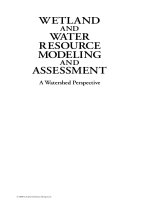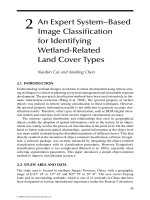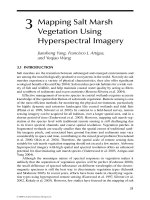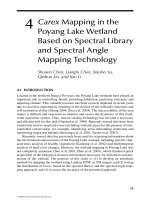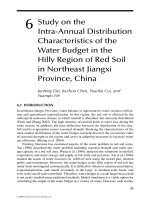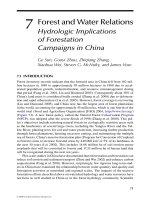PEOPLE AND WORK IN EVENTS AND CONVENTIONS: A Research Perspective
Bạn đang xem bản rút gọn của tài liệu. Xem và tải ngay bản đầy đủ của tài liệu tại đây (16.05 MB, 247 trang )
PEOPLE AND WORK IN EVENTS AND
CONVENTIONS
A Research Perspective
This page intentionally left blank
PEOPLE AND WORK IN
EVENTS AND CONVENTIONS
A Research Perspective
Edited by
Thomas Baum PhD
University of Strathclyde, UK
Margaret Deery PhD
Victoria University, Australia
Clare Hanlon PhD
Victoria University, Australia
Leonie Lockstone PhD
Victoria University, Australia
Karen Smith PhD
Victoria University of Wellington, New Zealand
CABI is a trading name of CAB International
CABI Head Offi ce CABI North American Offi ce
Nosworthy Way 875 Massachusetts Avenue
Wallingford 7th Floor
Oxfordshire OX10 8DE Cambridge, MA 02139
UK USA
Tel: +44 (0)1491 832111 Tel: +1 617 395 4056
Fax: +44 (0)1491 833508 Fax: +1 617 354 6875
E-mail: E-mail:
Website: www.cabi.org
© CAB International 2009. All rights reserved. No part of this publication
may be reproduced in any form or by any means, electronically, mechanically,
by photocopying, recording or otherwise, without the prior permission of the
copyright owners.
A catalogue record for this book is available from the British Library, London, UK.
Library of Congress Cataloging-in-Publication Data
People and work in events and conventions : a research perspective / edited by Thomas Baum
… [et al.].
p. cm.
Includes index.
ISBN 978-1-84593-476-7 (alk. paper)
1. Special events industry Employees Cross-cultural studies. 2. Special events
Planning Research. I. Baum, Tom. II. Title.
GT3405.P46 2009
394.2 dc22
2009001097
ISBN: 978 1 84593 476 7
Typeset by AMA Dataset, Preston, UK.
Printed and bound in the UK by MPG Books Group.
The paper used for the text pages in this book is FSC certifi ed. The FSC (Forest Stewardship
Council) is an international network to promote responsible management of the world’s forests.
Contents
Contributors vii
List of Figures xii
List of Tables xiii
Preface xv
Part I: Setting the Scene
1 The Events Industry: the Employment Context 3
Judith Mair
2 Event Management Employment in Australia:
a Nationwide Investigation of Labour Trends in
Australian Event Management 17
Charles Arcodia
Part II: Education and Career Development
3 Employability in the Cultural Events Sector: the
Role of Specialist Degree Programmes 29
Zuleika Beaven, Sara St George and Richard Wright
4 Career Profi les of Convention Industry Professionals in Asia:
a Case Study of Hong Kong 39
Adele Ladkin and Karin Weber
5 ‘Butterfl ying’ Career Patterns in the Convention and
Exhibition Industry 51
Vivienne McCabe
v
vi Contents
6 Career Theory and Major Event Employment 65
Leo Jago and Judith Mair
7 New Professionalism in the Event Sector and its
Impact in Hungary 75
Katalin Formádi and Csilla Raffai
Part III: Flexibility in Events Work
8 Managing Pulsating Major Sporting Event Organizations 93
Clare Hanlon and Leo Jago
9 Episodic Experiences: Volunteering Flexibility
in the Events Sector 108
Leonie Lockstone and Karen A. Smith
Part IV: Recruitment and Retention in Events and Conventions
10 Employee Retention Strategies for Event Management 127
Margaret Deery
11 Volunteer Recruitment and Retention: an
Australia–USA Comparison 138
Joe Goldblatt and Catherine M. Matheson
12 Involving and Keeping Event Volunteers: Management
Insights from Cultural Festivals 154
Karen A. Smith and Leonie Lockstone
Part V: Management of People and Work
13 The Psychology of Sport Event Volunteerism: a Review
of Volunteer Motives, Involvement and Behaviour 171
Russell Hoye and Graham Cuskelly
14 Managing Volunteers to Enhance the Legacy Potential
of Major Events 181
Christopher Auld, Graham Cuskelly and Maureen Harrington
15 High-adrenalin Work Environments at Events 193
Chris Kemp
16 Human Resources Perspectives on the Management
of Conferences as Events in Kenya 205
Roselyne N. Okech
Conclusion 217
Index 223
Contributors
Charles Arcodia is Head of Event Management at the University of Queen-
sland, Australia. He joined the university in 1996 after working in a number of
industries and in private enterprise. He has held leadership positions in a variety
of educational and business service contexts. Dr Arcodia completed his PhD in
organizational citizenship and has an active research agenda in areas relevant to
event management and broader tourism and leisure issues. His research interests
include event management and administration, cultural diversity in hospital-
ity and tourism management, and hospitality and tourism education. E-mail:
Chris Auld is a Professor and Dean (international) in the Griffi th Business
School, Griffi th University, Australia. His research interests include volunteer
management, board performance and governance in the non-profi t sector, sport
and leisure planning and management, and the impacts of major events. He is
currently on the editorial advisory board of the Annals of Leisure Research and
recently co-authored a research book entitled Working with Volunteers in Sport:
Theory and Practice (2006), published by Routledge. E-mail: c.auld@griffi th.
edu.au
Tom Baum is Professor of International Tourism and Hospitality Management
in the Department of Hospitality and Tourism Management, the University of
Strathclyde, Glasgow, Scotland. Professor Baum has a BA and an MA from the
University of Wales and a PhD from Strathclyde University. His research focuses
on the study of people and work in the context of tourism and hospitality. He has
published seven books and over 150 academic papers in this fi eld. E-mail:
Zuleika Beaven is a doctoral researcher into nascent musician entrepreneur-
ship at Birmingham City Business School, UK, and lectures in Cultural Man-
agement at the University of Winchester. Previously she was a senior lecturer in
vii
viii Contributors
Arts and Event Management at the Arts Institute at Bournemouth, where her
work focused on innovation in the cultural entrepreneurship curriculum. She
holds bachelor’s and master’s degrees in arts management, and has a research
interest in aspects of work in the cultural events industry. E-mail: zuleika.
Graham Cuskelly is a Professor and Dean (research) in the Griffi th Business
School, Griffi th University, Australia. His primary research and teaching interests
are in sport volunteers, community sport development, and governance of non-
profi t sport organizations. He recently co-authored Working with Volunteers in
Sport: Theory and Practice (Routledge, 2006) and Sport Governance (Elsevier,
2007) and is currently editor of Sport Management Review. E-mail: g.cuskelly@
griffi th.edu.au
Margaret Deery is Professor in Tourism and Events Management at Victoria
University, Melbourne, Australia, and a professorial research fellow in the Cen-
tre for Tourism and Services Research. She has worked with the Australian
government-funded Sustainable Tourism Co-operative Research Centre and
was Director of the Centre for Hospitality and Tourism Research. She has pub-
lished widely in the area of human resource management, event evaluation and
volunteer management as well as being the recipient of a number of research
grants in these areas. E-mail:
Katalin Formádi is a tourism lecturer at the Tourism Department, University of
Pannonia in Hungary. She holds a bachelor’s degree in tourism economics and
a master’s degree in economics and sociology from the Corvinus University in
Hungary; she is currently fi nishing her PhD in the sociology of professions from
Corvinus University, Budapest. She has publications in the area of the health
and wellness tourism and events sectors, including on the processes of profes-
sionalization and careers (Policy Press, 2008). She is an associated member
(as a PhD representative) of the Executive Board of RN19 ESA (the Sociology of
Professions Research Network of European Sociological Association). E-mail:
Joe Goldblatt, CSEP is Executive Director of the International Centre for the
Study of Planned Events at Queen Margaret University, Edinburgh. He is a lec-
turer in the Tourism, Hospitality and Events Group. Dr Goldblatt is the author,
co-author or editor of 19 books in the fi eld of events management. He served
as founding president of the International Special Events Society and was recently
inducted into the International Festivals and Events Association Hall of Fame.
E-mail:
Clare Hanlon is a senior lecturer in the School of Sport and Exercise Science
and member of the Centre of Ageing, Rehabilitation, Exercise and Sport at
Victoria University, Melbourne, Australia. Dr Hanlon is a member of the editorial
board for the Bulletin of Sport and Culture and an invited reviewer for refereed
sport and event journals. Her publications in this related management fi eld
address human resource management in major sport events, and training needs
of sport, tourism and recreation managers. E-mail:
Contributors ix
Maureen Harrington has a PhD in sociology from the University of California,
Santa Barbara. After teaching at the University of Ottawa, Canada from 1988 to
1995 in the Department of Leisure Studies, she moved to Australia, where she
has been teaching in the Department of Tourism, Leisure, Hotel and Sport
Management at Griffi th University, Australia. She has written on volunteering in
sport, women’s work, leisure and family lives, and gender and family leisure. Her
current research is on family leisure and children’s sport, healthy lifestyles and
notions of risk. E-mail: m.harrington@griffi th.edu.au
Russell Hoye is an Associate Professor in the School of Management, La Trobe
University, Melbourne, Australia. Associate Professor Hoye is a member of the
editorial board for Sport Management Review, the International Journal of Sport
Policy and the Australian Journal on Volunteering, and current president of the
Sport Management Association of Australia and New Zealand (SMAANZ). His
most recent books include Sport and Social Capital (2008), Sport Governance
(2007), both published by Elsevier, and Working with Volunteers in Sport: Theory
and Practice (2006), published by Routledge. E-mail:
Leo Jago is a Professor in Tourism at Victoria University, Melbourne, Australia,
and Director of the Centre for Tourism and Services Research. He has degrees in
engineering and economics, a master’s degree in business and a PhD. Over the
last 15 years, his research and publication interests have focused on event
management and evaluation. He is an associate editor of the Journal of Sport &
Tourism and on the editorial boards of a range of international journals, includ-
ing Event Management and the International Journal of Event Management
Research. E-mail:
Chris Kemp is an Executive Dean at Buckinghamshire New University, UK. He
is an expert in three specifi c areas: crowd and safety management, music and
venue management, and music genre classifi cation. Professor Kemp is widely
recognized for his work on the management of crowds and his ceaseless
endeavour to make events safer. He works with numerous organizations and
government bodies, undertaking research projects and publishing their results.
E-mail:
Adele Ladkin is Professor of Tourism Employment and Associate Dean for
Tourism and Hospitality within the International Centre for Tourism and
Hospitality Research, School of Services Management, Bournemouth University,
UK. She holds an MSc and a PhD in tourism from the University of Surrey. Her
publications are in the areas of career analysis and labour mobility in tourism
and hospitality and the conference industry. Professor Ladkin is editor in chief
for the International Journal of Tourism Research. E-mail: aladkin@bournemouth.
ac.uk
Leonie Lockstone is a lecturer in Event Management at Victoria University,
Melbourne, Australia. Leonie has pursued an interest in volunteer research
since commencing her PhD thesis in 2000, entitled ‘Managing the volunteer
workforce – fl exible structures and strategies to integrate paid and unpaid
workers’. The thesis examined relations between paid workers and volunteers in
x Contributors
the tourism sector, and the fi ndings led to the development of an innovative and
fl exible framework to assist organizations in effectively managing these valuable
human resources. In her current role, Leonie continues to undertake research on
volunteering and has expanded her focus to include the events sector. Her other
research interests include event management education, museum management
and commemorative events. E-mail:
Vivienne S. McCabe is an Associate Professor in Hospitality Management at
the University of South Australia. She holds a doctorate and a master’s degree in
business administration and professional qualifi cations of the Hotel, Catering
and Institutional Management Association (HCIMA). Associate Professor McCabe
has a passion for the convention and event sector, is an associate fellow of the
Meetings and Events Association of Australia (MEA) and serves as a state and
national judge of its industry awards. She is the lead author of the Australian text
The Business and Management of Conventions. E-mail:
Judith Mair is a postdoctoral research fellow in the Centre for Tourism and
Services Research at Victoria University, Melbourne, Australia. She holds an MSc
and a PhD in tourism, both from the University of Strathclyde, Glasgow. She has
published in the areas of consumer behaviour and business events, and also
event management education. E-mail:
Catherine M. Matheson is a lecturer in Events Management at Queen Margaret
University, Edinburgh. Her research interests lie within cultural policy, event-led
regeneration and event strategies. Dr Matheson has published work on authen-
ticity and Celtic music festivals and the heritage of festivals. Collaborative work
has centred on events and cultural policy and consumer motivations within
sporting events. Recent work has focused upon an evaluation of event-themed
regeneration strategies and sports policy. E-mail:
Roselyne N. Okech is an Assistant Professor in Tourism Studies at Sir Wilfred
Grenfell College, Memorial University of Newfoundland, Canada. She holds a
bachelor’s degree in commerce and a master’s in tourism administration from
India and a PhD in tourism from KwaZulu-Natal University, South Africa. She
has published in the area of tourism planning and management, appearing in
Anatolia and Journal of Human Resources in Hospitality and Tourism. She is
also a board member of ATLAS-Africa. E-mail:
Csilla Raffai is an assistant lecturer at the University of Pannonia, Hungary.
She holds bachelor’s and master’s degrees in economy and tourism. E-mail:
Karen A. Smith is a senior lecturer in Tourism Management at Victoria
Management School, Victoria University of Wellington, New Zealand. Her PhD
from Nottingham Trent University in the UK investigated the management of
volunteers in literary heritage attractions. She has published in the areas of event
ticketing and distribution, fi lm and literary tourism, and volunteer management,
and has a forthcoming book Managing Volunteers in Tourism: Attractions, Desti-
nations and Events, written with Kirsten Holmes and published by Elsevier. She
is on the editorial boards of the Journal of International Volunteer Tourism and
Contributors xi
Social Development, and the Journal of Vacation Marketing. E-mail: karen.
Sara St George is Head of Marketing & Development and Deputy Chief Exe-
cutive at Lighthouse, Poole‘s Centre for the Arts, Dorset, UK. At the time of wri-
ting, she was a senior lecturer in Arts Education and Arts and Event Management
at the Arts Institute in Bournemouth, UK. E-mail:
Karin Weber is an Assistant Professor in the School of Hotel and Tourism
Management, Hong Kong Polytechnic University, Hong Kong. Prior to joining
the school in 2001, she taught in marketing and tourism at Monash University,
Australia. A native of Germany, Karin received her Bachelor of Business (Hons)
degree from Monash University, her MSc degree in hotel administration from the
University of Nevada, Las Vegas, USA, and her PhD in services marketing from
Griffi th University, Australia. Assistant Professor Weber has published on a wide
range of subjects in leading international tourism and hospitality journals and
presented her research at international and national conferences. Her two major
areas of research interest are services marketing and convention tourism/manage-
ment. E-mail:
Richard Wright is a principal lecturer and has been course leader for the BA
(Hons) Arts and Event Management at The Arts Institute in Bournemouth, UK,
since its inception in 1993. He has taught on vocational programmes in specialist
art and design colleges for over 30 years, at Plymouth College of Art and Design
and AIB, and has a particular interest in embedding employability in the curricu-
lum through live event projects and work placements. E-mail:
List of Figures
Fig. 5.1 Convention and Exhibition Sales and Marketing Director.
Fig. 5.2 General Manager – Convention and Exhibition Venue.
Fig. 5.3 Director/Partner Professional Conference Organization.
Fig. 5.4 Convention and Exhibition Services Director – Venue.
Fig. 11.1 Conceptual volunteer motivation typology.
Fig. 11.2 Conceptual volunteer points of engagement model: key touch points
of the volunteer experience.
Fig. 11.3 Technology engagement model for convention and event volunteers.
Fig. 11.4 Volunteer experience life cycle before, during and following the event.
Fig. 12.1 Main recruitment and screening methods for festival volunteers.
xii
List of Tables
Table 1.1 Numbers attending events in Australia, 2005–2006.
Table 1.2 Numbers of staff compared with attendance numbers.
Table 2.1 Advertised skill requirements.
Table 2.2 Advertised attribute requirements.
Table 4.1 Demographic profi le of the sample.
Table 4.2 Career path by industry sector.
Table 4.3 Career path by level of responsibility.
Table 4.4 Career identity.
Table 4.5 Career commitment.
Table 7.1 Professional associations representing Hungarian event managers.
Table 7.2 Required experience, abilities and skills of event managers.
Table 9.1 Volunteer profi le.
Table 9.2 Extent of episodic volunteering.
Table 9.3 Descriptive profi le – types of fl exibility.
Table 9.4 Descriptive profi le – organizational characteristics.
Table 9.5 Flexibility options available to episodic volunteers.
Table 11.1 Australia and the USA: volunteer similarities and differences.
Table 11.2 Australia and the USA: volunteer motivations.
Table 11.3 Volunteer preferences from a major festival in the USA.
Table 11.4 Key strategies for retaining convention and event volunteers.
Table 11.5 Five ways to effectively recognize and reward convention
and event volunteers.
Table 12.1 Profi le of festivals.
Table 16.1 Conferences in Kenya, 2002–2006.
xiii
This page intentionally left blank
Preface
The events and conventions sector represents a fascinating and challenging area
in terms of the structure and dynamics of the employment environment it sup-
ports. It is a sector generally neglected in wider discourse and research into the
labour process and employment analysis. Work and employment in the events
and convention sector refl ects a range of contextual and operational characteris-
tics that impact on who works in the sector, the range of skills that they require and
the conditions under which they undertake their work and, arguably, distinguishes
work in the sector from other related areas. These characteristics include:
The time-bound nature of events and conventions in terms of their organiza-
●
tion and delivery, in so far as they are generally of short duration and may
be one-off in a location or may reoccur, often on an annual basis.
Peripatetic, in that many events rotate around a number of locations on a
●
periodic basis.
Diverse in scale, geographic focus and emphasis, encompassing both leisure
●
and business events.
Frequently events are highly dependent on volunteers for their organization
●
and working contributions.
Characterized by what might be called a ‘petrol head’, ‘opera buff’ or ‘celebrity
●
gazing’ syndrome, in that many events attract employees and volunteers
personally committed to the theme of the event in a way that impacts upon
their expectations of conditions and remuneration.
Within this environment, events and convention work demand the delivery
of a range of bundled skills, which may encompass technical, emotional, aes-
thetic, problem-solving and information-processing facets. This combination of
skills, delivered in the complex contextual framework identifi ed above, provides
workplace challenges that are unique to the sector and demanding of further
examination.
xv
xvi Preface
Events, as Mair rightly points out in Chapter 1 of this book, are no new
phenomenon. Events, whether ceremonial, religious or sporting, have featured
in all organized societies from earliest recorded time and continue to be an
important dimension of contemporary living at a local, national and global scale.
Clearly, alongside ancient events was to be found a level of organization and a
requirement for workers to support such events, in their development and set up,
delivery and post-event dismantlement. What is unclear is the status of those
engaged in event organization in terms of their demographics, relationship to
those leading the event, whether political or religious, or indeed whether they
were free citizens or enslaved labour. Discussion of such ancient events in the
literature today does not give us much indication of their organization or who the
event workers were, although we may surmise answers to some of these quan-
daries – their frequent religious or political context means that the primary source
for organization would have been within the respective religious or political elites
or, indeed, both groups. Slave labour was commonplace in ancient societies,
such as those in Egypt, Greece and Rome, so it is reasonable to assume a sig-
nifi cant role for this class of workers at major events. Notwithstanding many
evident differences between events in the ancient world and those with which we
are familiar today, the nature of organization and work is likely to have included
many tasks with which contemporary event organizers will be familiar.
Although employment in events organization, management and service
delivery is clearly not a new phenomenon, its recognition as a discrete area of
work, demanding specifi c skills, education and training, is relatively recent. One
of the challenges in this regard is that events, in common with allied areas in
leisure, tourism and hospitality, represent an amorphous and diverse fi eld of
economic, social and cultural activity, and the resultant employment likewise
covers a wide range of activities and organizational/operational contexts.
Recognition of the discrete requirements of the events and convention sector
has been manifest through the emergence of specialist educational programmes
at vocational and university level in many countries and specialist publications
and texts in event management and operations. At the same time, recognition
has grown of the events management sector in employment terms, with moves
towards professionalism at national and international levels.
Human resource, education and training themes in the context of events
have attracted the recent interest of researchers because of the particular dyna-
mics of work in the sector, coalescing mainstream ‘conventional’ employment
with a wide range of time-bound, episodic work on both a paid and a voluntary
basis. These dynamics present challenges in conceptual, theoretical, managerial
and operational terms. This book is an attempt to bring together the main strands
of research-informed debate relating to these challenges, drawing on experiences
from a range of countries.
The book is organized into fi ve parts. The fi rst two chapters set the scene
with respect to events and employment within the sector, focusing on a global
review and an Australian case context. Subsequent parts consider education and
career development in the events and convention sector, workplace fl exibility in
the context of events, recruitment and retention, and the management of people
and work in events and conventions.
1
I
Setting the Scene
This part sets the scene, and Mair (Chapter 1) provides an overview of the events
industry in an employment context. She details the growth of the global events
industry and considers classifi cations of events in terms of size and type. Through
examples of attendance numbers at a selection of mega and major events, Mair
contrasts audience size with the numbers of people employed in both paid and
volunteer positions. She introduces the increasing recognition of event manage-
ment as a profession, a theme that is subsequently taken up in other chapters
(see Part II). She highlights the diversity of work within the sector and concludes
by discussing the broad range of employment opportunities on offer.
This diversity of event work is taken up by Arcodia in Chapter 2. He reports
on an ongoing study of event management employment in Australia. Presenting
data from a content analysis of job advertisements, he identifi es the key skills
and attributes of event managers. The chapter concludes by noting that while
some skills are generic professional skills (such as communication, problem
solving and leadership), others are more specifi c to the requirements of event
management work (namely planning and organizational, marketing, fi nancial
and computer skills).
This page intentionally left blank
© CAB International 2009. People and Work in Events and Conventions:
a Research Perspective (eds T. Baum et al.) 3
1
The Events Industry:
the Employment Context
JUDITH MAIR
Victoria University, Melbourne, Australia
Introduction
This chapter sets the scene with respect to the global events industry and con-
siders defi nitions of different types and sizes of events. It also examines human
resource characteristics of the events industry, including consideration of some of
the job functions and positions available in the industry, both paid and volunteer.
The Events Industry – a Dynamic and Growing Sector
Events have played an important part in human societies for thousands of years.
Throughout history, people both ancient and modern have felt the need to mark
particular dates and times with many kinds of ceremonies or celebrations. These
range from the ancient celebrations of midsummer and midwinter to the wide
range of religious festivals, royal coronations and other ceremonies throughout
recorded history, and the contemporary celebrations that highlight birthdays,
festivals and national days. Goldblatt (1990:1) notes that the need to celebrate is
‘perhaps even more vital to the sustenance of the human spirit’ than the physical
needs of food, clothing and shelter. This serves to highlight the importance of
events to the human psyche and underlines the emphasis that people have
always placed on marking particular dates, seasons and life stages.
Historically, it may have been the case that attendance at events was a man-
datory part of belonging to a particular community or religion, or at least was
considered to be benefi cial to the attendee. Organizing events was part of the
‘job description’ of religious leaders and royal courtiers and it is only compara-
tively recently that organizing events has been considered to be a job, or even a
profession in its own right.
For most events, attendance is no longer compulsory but instead is at the
discretion of the individual (exceptions may occur, however; for example, some
4 J. Mair
corporate events are mandatory for employees, and within some political
regimes, participation was, and still is, expected of ranks within the political
establishment). Events catering to particular interests and enthusiasms are now
commonplace – there is a huge variety of sporting events, special interest con-
ventions, exhibitions and music festivals, as well as countless other events world-
wide from which to choose, and understanding motivations to attend these
different types of events is invaluable to the organizers in trying to maximize
attendance.
Events can be fun in themselves, but they also add to the richness of the lives
of those attending. Amongst other things, they can be entertaining, they can be
competitive, they can be intellectually stimulating, they can engender commu-
nity or national pride, and they can be representative of beliefs and faiths. They
appeal to a broad range of people and they are becoming more and more numer-
ous. Indeed, events have been described as ‘. . . one of the most exciting and
fastest growing forms of leisure, business, and tourism-related phenomena’ (Getz
1997:1). Globally, both non-profi t and for-profi t events have grown substantially
to become a major area for investment, and the economic, social and environ-
mental impacts of events are growing all the time. The industry is dynamic and
exciting and offers tremendous opportunities both to those destinations that host
events and to those who choose to work in this area. Few other industries are as
diverse and diffi cult to defi ne as the events industry and a glance at the wide
variety of events that make up the industry will illustrate this point.
Event Classifi cation
There is no strict classifi cation of events that can be used to describe and analyse
the events industry. However, there are certain classifi cations that are commonly
used and the two main categories are by size and by type.
Classifi cation by size
As has already been mentioned, events can be extremely diverse and range in
size from local community festivals to the Olympic Games. There are a number
of labels that can indicate the size of an event, but some of the most often used
are mega-events, hallmark events, major events and local events. Within these
types there are, of course, a myriad of different-sized events.
Mega-events
Mega-events are defi ned by Allen et al. (2005) as ‘those that are so large they
affect whole economies and reverberate in the global media. They include Olym-
pic Games and World Fairs.’ Additionally, Getz (1997:6) suggests that mega-
events should have more than one million visitors, capital costs of at least US$500
million and a reputation as a ‘must see’ event. He goes on to say that ‘mega
events, by way of their size or signifi cance, are those that yield extraordinarily
high levels of tourism, media coverage, prestige or economic impact for a host
Events Industry Employment Context 5
destination’. Mega-events are of such a large scale that they permeate into almost
every aspect of life at the destination during the event – transport, retail, hospital-
ity, even industry and healthcare. Mega-events require large numbers of people,
working not only on the running of the event but also on the ongoing organiza-
tion. This may mean working on the current event and also working on the bid-
ding process for future events. During the event itself, vast numbers of volunteers
are usually engaged to make the event run as smoothly as possible.
According to an economic impact analysis of the Commonwealth Games in
Melbourne in 2006, ‘over a twenty year period, the holding of the Commonwealth
Games in Victoria is estimated to support 13,000 person years of employment in
full time jobs and in 2006 create some 22,000 casual jobs’ (OCGC, 2006:39). The
same report showed that a study of the 2002 Manchester Commonwealth Games
by the Manchester Council indicated that, with expected public sector investment
of £277 million, there would be 6100 FTEs of employment created in Manchester
and 17,000 jobs during the conduct of the games.
Hallmark events
Hallmark events on the other hand are not on such a huge scale. The defi ning
characteristic of a hallmark event is that it takes place repeatedly in the same
destination, to the extent that mention of the event automatically brings to mind
the location where the event is held. Some hallmark events are very large, but
most will not involve the huge numbers that attend mega-events. In fact, it can
be argued that some fairly small events fulfi l the criteria for being considered as
hallmark events. Hallmark events are described as ‘those events that become so
identifi ed with the spirit or ethos of a town, city or region that they become syn-
onymous with the name of the place, and gain widespread recognition and
awareness’ (Allen et al., 2005). Examples are the Oktoberfest (Munich), the Car-
nival (Rio de Janiero), Mardi Gras (New Orleans) and others such as the Edin-
burgh Festival. Getz (1997:6) suggests that ‘Increasingly, every community and
destination needs one or more hallmark event to provide the high levels of media
exposure and positive imagery that help to create competitive advantages’. The
people working on hallmark events are usually involved in a circular process –
analysing the impacts and success or otherwise of past events, working on orga-
nizing the current event and planning for future events. Volunteers are often
engaged to work at hallmark events, and as the event takes place repeatedly in
the same destination, the same volunteers often return year after year.
Major events
Major events, by contrast, may on occasion actually involve more people than a
hallmark event, and with examples such as the F1 Grand Prix, the Grand Slam
tennis tournaments, Glastonbury Music Festival and a host of sporting grand
fi nals it can easily be seen that these events are of major signifi cance. They have
enormous pulling power in terms of visitors, performers/competitors and media,
and they generate a signifi cant economic impact for their host destinations.
Destinations work hard to attract major events, and to encourage them to return
on an annual basis. Melbourne is the location of the Australian Open Tennis
Championships, London plays host to the Wimbledon Tennis Championship
6 J. Mair
and the FA Cup Final, and Paris is the location for the fi nale of the Tour de
France. These destinations often have to put a lot of effort into keeping these
attractions – for example, Melbourne has been challenged for both the Austra-
lian F1 Grand Prix and the Australian Open Tennis Championship. The rewards
of hosting these events are generally felt to be worth the effort in securing them,
although they can be a source of fi nancial concern, as the events themselves do
sometimes lose money. The people who work on major events are often affi li-
ated with the organization that stages the event – the Football Association or the
Australian Tennis Association, for example. Organizing the annual major event
for their association may be their full-time job, but it may be the case that people
with other roles within the association (perhaps marketing or fi nance) will be
involved immediately prior to and during the event itself. Major events are also
a source of employment for casual labour (to work on food stalls, for example)
and attract numbers of volunteers.
Local or community events
The fi nal generic event size is local, also known as community events. These are
small-scale events, often taking place over 1 or 2 days and usually involving the
local community. Local community events may be defi ned as ‘an activity estab-
lished to involve the local population in a shared experience to their mutual
benefi t’ (Berridge, 2007).They are generally organized and run by volunteers,
with minimum fi nancial assistance from the private sector. They are often held to
showcase a particular local trade or community, or simply for fun. These local
events can also be held with the purpose of increasing tolerance of a particular
section of the community, or with an educational message. Additionally, sport is a
common reason for holding a local event. Local events often have a strong fund-
raising element – perhaps raising money for a local school, sporting club or charity.
These types of events often rely on the attendance of the local population as they
are not always marketed outside the immediate vicinity. However, some hallmark
events started out as small local events and have grown to represent much more.
For example, the Notting Hill Carnival began life as a small-scale event with the
aim of showcasing local talent and bringing together the community. It has now
grown into a multi-million pound event, attracting large numbers of performers
and a huge audience. Most local events do not have any full-time staff employed
to put on the event, but rather rely on volunteers or sometimes part-time adminis-
trative assistance. Volunteers are essential to local events, both as members of the
organizing committee and to help during the staging of the event.
Classifi cation by type
Another common way of classifying events is by type of event rather than by size.
There are sporting events, charity events, music events, arts events and cultural
events, amongst others. This list is not exhaustive and there is no clearly accepted
typology of events – Shone and Parry (2004) suggest leisure events, personal
events, cultural events and organizational events (charitable, commercial, political
and sales). Getz (2007), on the other hand, suggests cultural celebrations, political
Events Industry Employment Context 7
and state events, and arts and entertainment in one category; business and trade,
and educational and scientifi c events in another category; sport competitions
and recreation in a third; and, fi nally, personal events form a category of their
own. Even where the overall event types are similar, there is little consensus as to
how to group them. For example, Van der Wagen (2005) suggests a category of
events including entertainment, art and culture. O’Hara and Beard (2006), how-
ever, suggest a category which they call ‘music, arts and entertainment’. For
Ali-Knight and Robertson (2004), the arts and cultural events are grouped together
but entertainment events are not included. It appears that any grouping of event
types is largely subjective and possibly not even very helpful. However, for the
purposes of this chapter, some of the main event types will be discussed – sporting
events, business events, music and entertainment events, and arts and cultural
events. Other event types, such as charity events, political events and family events,
are relatively self-explanatory and do not require further discussion at this point.
Sporting events
Sporting events are relatively easy to defi ne. As the name suggests, these events
are all held for the purpose of sporting competition. Sporting events are held all
over the world, and the top events attract the world’s best athletes. Some of the
more famous international sporting events include the F1 Grand Prix competi-
tion, the European Football Championships and World Cup, the Rugby World
Cup, the Grand Slam Tennis Tournaments and, of course, the Olympic and
Commonwealth Games. Individual countries have their own major sporting
events – for example, the FA Cup Final in England (football), the New York
Marathon in the USA (and other marathons around the globe), the Melbourne
Cup in Australia (horse racing), and the Tour de France in France (cycling race).
However, it is important to remember that sporting events take place at all
levels – even the local Sunday football league matches, and Little Athletics com-
petitions are sporting events. According to the Australian Bureau of Statistics, 7.1
million people in Australia attended at least one sporting event in 2005 (ABS,
2007a). That represents two-fi fths of the Australian population over 15 years of
age. In 2001, 462 million people attended organized sports events in the USA
and Canada (Supovitz, 2005). This begs the question – why do so many people
attend sporting events? According to Supovitz (2005:5), ‘what makes sports
events the world’s most compelling entertainment form is the emotional capital
the audience invests in the outcome of the contest’. This certainly differentiates
sporting events from other types of events.
Getz (2007) suggests that sporting events can be characterized according to
a number of potential factors:
professional versus amateur;
●
indoor versus outdoor; ●
regular/scheduled versus one-off; and ●
local, regional, national or international in scale. ●
Major sporting events are also characterized by particularly heavy sponsor-
ship, from vast corporations such as Nike, Reebok, Motorola, IBM and Coca-Cola
8 J. Mair
to slightly smaller companies such as Carling, ING, Barclays Bank and Timex.
Supovitz suggests that corporations continue to sponsor sporting events because
‘their customers, in record numbers, likewise continue to devote their dollars and
emotions’ (Supovitz, 2005:6).
Business events or, as they are sometimes known, the meetings, incentives,
conferences and exhibitions (MICE) sector
According to McCabe et al. (2000), the business events sector is one of the
fastest-growing and most lucrative areas of the tourism industry. It is estimated
that 1.46 million conferences and meetings took place at UK venues during 2002
(BCVS, 2004). One of the key fi ndings of the National Business Events Study in
Australia was that, in 2004, business events generated annual expenditure of
AUS$17.36 billion and created 214,000 Australian jobs (Deery et al., 2005), and
therefore it can be seen that this sector is a vitally important component of the
events industry as well as the travel industry.
Meetings are generally smaller affairs, with fewer delegates, and can be held
on company premises, in hotels, or in purpose-built meeting rooms. The term
‘incentive’ refers to a type of travel where a company pays for an employee to
travel, sometimes to attend a conference or exhibition, sometimes for pleasure,
as a reward for work-related performance. Conferences and conventions are
generally understood to be large gatherings of like-minded individuals, who
come together for professional or personal development purposes, for network-
ing purposes and for educational purposes.
Exhibitions are well known and refer, of course, to large-scale showcasing of
products and services. In the UK, research conducted by KPMG for the Associa-
tion of Exhibition Organizers and the Association of Event Venues showed that
the industry was worth £9.3 billion, with direct employment of almost 56,000
people, and with indirect employment estimated to be 136,000 (Berridge, 2007).
Additionally, Europe as a whole now has over 15 million m
2
of exhibition space
and a market share of 57%. This serves to underline both the current success of
the exhibition sector in particular and the importance of business events to the
economy. Exhibitions can be trade only, where attendees have to work in what-
ever industry is being showcased, or can be consumer or public, where anyone
can attend. In the travel industry, the World Travel Market in London and the
Internationale Tourismus Borse (ITB) in Berlin are examples of trade-only events,
whilst The Holiday & Travel Show is a consumer exhibition. Other consumer
shows includes hobby and special interest fairs, food and wine festivals (a grow-
ing area for events) and gardening shows. Probably the largest type of exhibition
is the World Expo, held in various countries around the world. The most recent
were held in Japan in 2005 and Shanghai in 2008.
Music and entertainment events
Music and entertainment events are able to attract some of the largest audiences
of any type of event. Vast-scale events such as Live 8, which included ten ven-
ues, 150 bands and 1250 musicians, have demonstrated the pulling power of
such events. The organizers estimated a global audience (in person and on tele-
vision and the Internet) of 3 billion (Live 8, 2007). Of course not all music events



